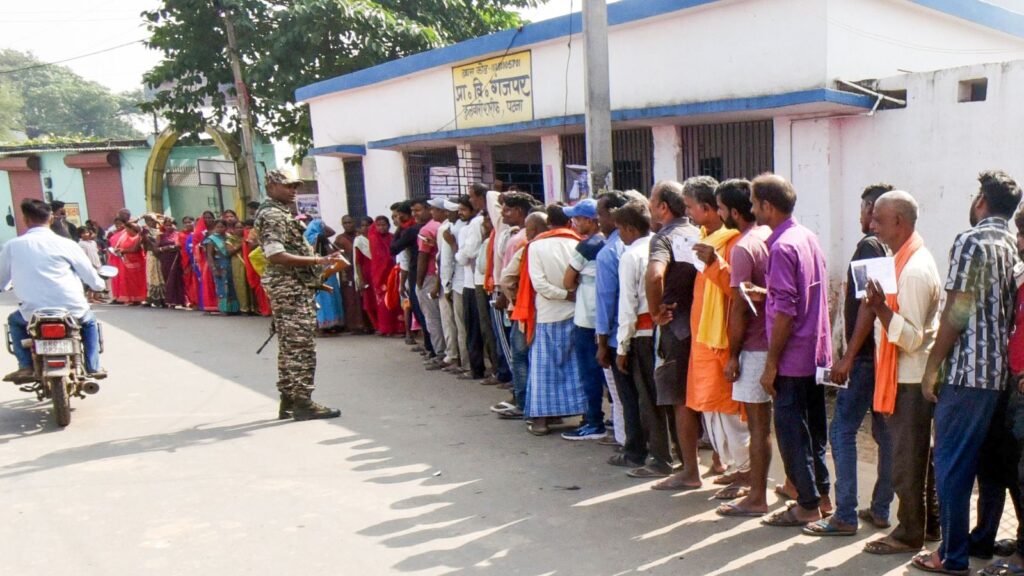The top leadership of both the ruling NDA and the Opposition Mahagathbandhan are claiming that the increase in voter turnout in the Bihar Assembly elections, the results of which will be declared on Friday, has gone in their favour.
Bihar saw an overall 66.91% voter turnout over two phases of polling, which is the highest since the first Assembly elections in the state in 1951, and an increase of 9.62 percentage points over 57.29% in 2020.
In states where electoral contests are largely bipolar, such as Bihar, the traditional wisdom is that an increase in voter turnout suggests the possibility of a change of government. But where smaller parties could play key roles by cutting votes, no side can be sure. However, given how close the 2020 elections were, this huge surge in voting is expected to be decisive.
Over the past 17 Assembly elections in Bihar, there have been five instances when an increase in the voter turnout was followed by a change in the government.
The first change of power happened in 1967 when the Jan Kranti Dal unseated the Congress, after seven terms in power. That year, the voter turnout had seen an increase by 7.04 percentage points over the previous election, to 51.51%.
Two years later, the Congress returned to power, in another change of regime coinciding with an increase in voter turnout — though marginally, by 1.28 percentage points, to 52.79%.
In 1977, the Janata Party came to power, ending two consecutive Congress terms. This time there was a decrease in the voter turnout from the previous elections by 2.28 percentage points, to 50.51%.
The Congress bounced back in 1980, after the voter turnout again increased, by a significant 6.77 percentage points, to 57.28%. The Congress retained power in 1985, when there was a marginal decline of nearly 1 percentage point in the turnout, to 56.27%.
In the 1990 elections, the voter turnout again increased, and for the first time crossed the 60% mark, to 62.04%. The election brought the Janata Dal to power, and Lalu Prasad became the Chief Minister for the first time.
Before the 1995 Assembly polls, Lalu’s “younger brother” Nitish Kumar and his “guru” George Fernandes quit the Janata Dal to form the Samata Party (that later became the Janata Dal-United), which aligned with the BJP against Lalu. However, Lalu retained power with his Janata Dal winning 167 of the 324 seats, as the voter turnout dipped slightly to 61.79%.
By 2000, Lalu was at the helm of the Rashtriya Janata Dal (RJD), and again came to power after the voter turnout increased by less than 1 percentage point to 62.57%.
In February 2005, after a massive 16.07 percentage point fall in the turnout to 46.5%, no party could form the government in Bihar. Following a period of President’s Rule, fresh elections were held in October that year. The turnout dropped further to 45.85%, and the JD(U), in alliance with the BJP, came to power, and Nitish became the CM for the first time.
In every election since October 2005, the footfall of voters at polling booths has been consistently rising – from 52.73% in 2010 and 56.91% in 2015 to 57.29% in 2020. In the 2015 elections, a rare instance in which the JD(U) did not ally with the BJP, Nitish retained the CM’s post after forming a Mahagathbandhan government with the RJD and Congress.
Past results in seats where turnout rose
Out of the 243 Assembly seats in Bihar, there are 20 constituencies where the absolute voter turnout (that is, the actual number of people who voted) increased by more than 15% compared to 2020. The highest increase of 17.86% was recorded in the Belsand Assembly seat, 17.84% in Mohiuddinnagar, and 17.81% in Jhajha.
Including these 20 seats, there are a total 132 seats where the increase in voter turnout this time was above 10%, which could make a difference in the results.
In the 2020 Assembly elections, of these 20 seats, the JD(U) had won the most, 7, and ally BJP 5. The RJD, too, had won 5 seats and ally Congress 1. NDA constituent Hindustani Awam Morcha (Secular) had won one seat, while another seat was won by an Independent.
In the 2020 elections, the highest increase in the turnout percentage was 9.76 percentage points in the Chakai seat. There were only eight seats where the turnout increased by more than 5 percentage points. In these eight seats, the winning parties were different from the 2015 results in six seats.
In 2015, there were only three seats – Katoria, Dhaka, Sitamarhi – where the increase in turnout was above 10 percentage points. That increase in the turnout was followed by a change in the MLA in each of these constituencies. In the 2010 polls, the BJP had won 2 and an Independent 1 of these seats.
In the 2015 elections, an increase of more than 5 percentage points in the turnout over the 2010 elections was recorded in 83 seats. In 45 of these seats, voters elected a different party from the 2010 winner, with the remaining 36 seats retained by the previous winner.

